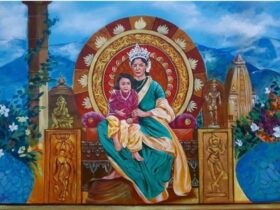Writes Shahzad Hussain Hamdani
Angelina Grimke and her sister Sarah Grimke were legends in their own lifetimes. They being daughters of a plantation owner had come to loathe slavery and all its degradations that they knew intimately. They had hoped that their new faith would be more accepting of their abolitionist beliefs than had been their former. However, their initial attempts to attack slavery caused them difficulties in the Quaker community. Nevertheless, the sisters persisted despite the additional complication caused by the belief that the fight for women’s rights was as important as the fight to abolish slavery. The Grimke sisters were among the first abolitionists to recognize the importance of women’s rights and to speak and write about the cause of female equality.
What made Angelina and her sister Sarah unique within abolitionist circles was neither their oratorical and literary talents nor their energetic commitment to the causes of racial and gender equality. What made them exceptional was their first-hand experience with the institution of slavery and with its daily horrors and injustices
While Sarah Grimke was born in South Carolina and was sixth of fourteen children and the second daughter of Mary and John FaucheraudGrimke, a rich plantation owner who was also an attorney and a judge in South Carolina; Angelina Grimke was the youngest of fourteen children born to John Grimke and Mary Smith Grimke. As the daughters of one of Charleston’s leading judges, both the sisters could look forward to a life of luxury and ease, their comfort assured by the presence of slaves trained to respond to their wishes. As eligible young women, they could have enjoyed their lively social life but Sarah and Angelina Grimke chose a different path: Both of them devoted their life to racial and gender equality.
Angelina’s self-imposed exile from her family and her hometown was not the result of a personally unhappy childhood. Although her own mother was somewhat distant, her older sister Sarah doted on her and, as the youngest member of the family; she was often the center of attention. But in the world around her, Angelina witnessed suffering that disturbed her: a young slave boy who walked with difficulty due to the whip-mark scars on his back and legs; family slaves who were mistreated and abused; and screams of pain from the nearby workhouse, where slaves were dragged on a treadmill, suspended by their arms.
It was not in Angelina’s character to remain silent about these injustices. Angelina was not content to pursue her own salvation quietly. Having reformed herself, she set out to reform her family, eager to change the views of her mother, sisters, and brothers, and anxious to enlighten them as she believed herself to be enlightened. Compelled to speak out, she antagonized her family by criticizing their love of finery, their idleness, and above all, their acceptance of slavery. Perhaps to her surprise, she could not win over her mother or her siblings. “I am much tried at times at the manner in which I am obliged to live here,” she wrote in her journal. By 1829, she had resolved to live there no longer.
In November of 1829, Angelina moved to Philadelphia, where Sarah had already settled. While most Philadelphians did not share Angelina’s abolitionist sentiment, she did find a small circle of anti-slavery advocates. Still, she was uncertain what she could do for the cause of abolition. She began attending anti-slavery meetings, encouraged by some male abolitionists’ call to women to become activists in the movement. In 1835, she was disturbed by violent riots and demonstrations against abolitionists and African Americans in New York and Philadelphia, and by the burning of anti-slavery pamphlets in her own hometown of Charleston
Joining her sister in the American Anti-Slavery Society in 1836, Sarah originally felt that she had finally found the place where she truly belonged, in which her thoughts and ideas were encouraged. However, as Angelina and she began speaking not only on abolition, but also on the importance of women’s rights, they both began to face much criticism. Their public speeches were seen as unwomanly because they spoke to mixed audiences, called “promiscuous audiences” at that time. Not only did they speak to mixed company, but they also publicly debated men who disagreed with them. This was too much for the general public of 1837 and caused many harsh attacks on their womanhood, one main thought being that they were both just poor “spinsters” displaying themselves in order to find any man who would be willing to take them
In January and February of 1837, the sisters toured New York State, filling churches with the sympathetic, the curious, and the hostile. “It is wonderful,” Angelina wrote, “how the way has been opened for us to address mixed audiences.” But opposition to women in the public sphere had not vanished. Repeatedly, Angelina found herself forced to defend a woman’s right to speak on a political issue. Each time she countered criticism by pointing out that women were citizens and had civic duties as serious as men’s. On July 17, in Amesbury, Massachusetts, two young men challenged Angelina to a debate over slavery and over women’s right to a public voice. It was the first public debate of this type between a man and a woman. An eyewitness described Angelina as “calm, modest, and dignified in her manner,” and declared that she had “with the utmost ease brushed away the cobwebs, which her puny antagonist had thrown her way.”
Although Sarah was a poor public speaker—unlike Angelina, who mesmerized audiences—she was Angelina’s equal when it came to the written word. In July 1837, the first of Sarah’s remarkable “Letters on the Equality of the Sexes” appeared in the New England Spectator, with its simple but powerful demand: “All I ask our brethren is that they will take their feet from off our necks, and permit us to stand upright on that ground which God designed us to occupy.”
Sarah Grimke died at the age of 81 in December of 1873. Angelina, who had been paralyzed for several years because of strokes, died on October 26, 1879. All two had lived to see the end of slavery and the rise of a women’s rights movement. At the time when women did not speak in public, these two sisterswere viewed as the feminist ground breakers.
The Article is based on some sources from the Wikipedia.


















Leave a Reply